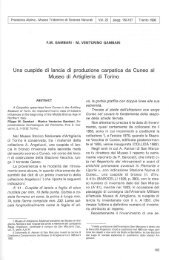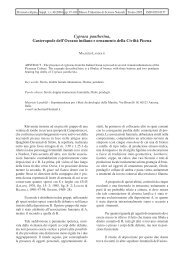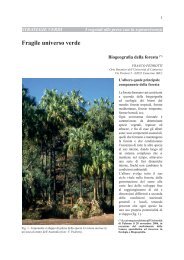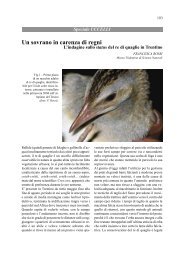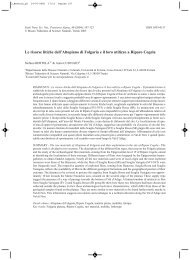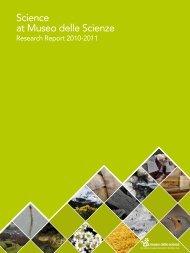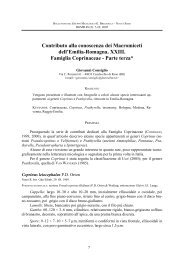scarica pdf 48285.958KB - Museo Tridentino di Scienze Naturali
scarica pdf 48285.958KB - Museo Tridentino di Scienze Naturali
scarica pdf 48285.958KB - Museo Tridentino di Scienze Naturali
Create successful ePaper yourself
Turn your PDF publications into a flip-book with our unique Google optimized e-Paper software.
ZUSAMMENFASSUNG<br />
Das àneolithische Graberteld von Cumarola bei Maranello <strong>di</strong><br />
Modena wurde um <strong>di</strong>e Mitte des vorigen Jahrhunderts entdeckt. Die<br />
Skelettreste und Beigaben von unqetanr vierzig Korperqràbern gingen<br />
zum groBten Teil verloren.<br />
Die Wiederentdeckung einiger unpublizierter Fundgegenstande<br />
in der Galleria Estense in Modena bot <strong>di</strong>e Gelegenheit zu einer allgemeinen<br />
Revision der zur VerfOgung stehenden Daten und zu einer<br />
kulturellen und chronologischen Einordnung <strong>di</strong>eser Gruppe von<br />
Bestattungen .<br />
Das Gràberteld von Cumarola ist - trotz elqenstàn<strong>di</strong>qer ZOge <br />
dem seiben Kulturgebiet wie <strong>di</strong>e Gruppe von Spilamberto (ebenfalls<br />
im Modenese) zuzurechnen, <strong>di</strong>e ihrerseits deutliche Verwandtschaftsbeziehungen<br />
zu den Kreisen von Rinaldone und Gaudo sowie<br />
der Remedello Kultur in der ostllchen Poebene erkennen laBt.<br />
Die Beìqaben-Auswahl von Cumarola ist gekennzeichnet durch<br />
das Vorkommen von Kupferbeilen und trianqulàren Kupferdolchen<br />
des Remedello Typs anatolischer Herkunft sowie von geschliffenen<br />
Steinbeilen und Lochaxten des Rinaldone Typs. Ebenso charakteristisch<br />
erscheint das Fehlen von Keramik.<br />
Absolutchronologisch dOrfte <strong>di</strong>e Graberqruppe von Cumarola,<br />
ebenso wie jene von Spilamberto und Remedello, im wesentlichen<br />
dem letzten Viertel des 3. Jahrtausends v.Chr. anqehoren.<br />
(traduzione: R. Lunz)<br />
78<br />
SUMMARV<br />
The Aeneolithic necropolis of Cumarola near Maranello <strong>di</strong> Modena<br />
was <strong>di</strong>scovered around the middle of the last century. The<br />
skeletal remains and belongings of about forty buried were virtually<br />
ali lost. .<br />
The <strong>di</strong>scovery, at the Estense Gallery of Modena, of previously<br />
unknown buried people's things belongings provided a good opportunity<br />
to review the data so far collected and to piace this sepulchral<br />
facies in its chronological and cultural setting.<br />
The Cumarola necropolis, with its own characteristics, is set in<br />
the same cultural area as the Spilamberto Group - also near Modena<br />
- which shows definite peninsular similarities with the Rinaldone<br />
and Gaudo spheres and with the Remedello Culture in the<br />
Eastern Lombardy plain.<br />
The objects accompanying the dead at Cumarola are characterized<br />
by the presence of copper hatchets and cooper triangular<br />
"Remedellian" daggers of Aegean-Anatolian derivation, of smooth<br />
stone axes and hatchets, of "Rinaldonian" axes and the absence of<br />
ceramic vessels.<br />
Accor<strong>di</strong>n to a non-calibrated chronology the Cumarola burialground,<br />
like those of Spilamberto and Remedello, must have been<br />
in use mostly durinq the last quarter of the third millennium B.C.<br />
(traduzione: S. Perini)



